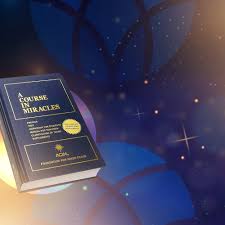Understanding A Course in Miracles: A Pathway to Inner Peace and Spiritual

In a world often clouded by fear, judgment, and conflict, the yearning for peace, purpose, and deeper understanding is universal. A Course in Miracles (ACIM), a spiritual text first published in 1976, presents a unique path to achieving this inner peace through forgiveness, love, and a profound shift in perception. Revered by many spiritual seekers and misunderstood by others, ACIM offers a radical reinterpretation of traditional Christian themes, emphasizing the power of the mind in shaping experience and the illusory nature of the world as we see it.
At its core, ACIM is not affiliated with any particular religion, although it uses Christian terminology and symbols. It was authored by Helen Schucman, a clinical psychologist, who claimed the content was dictated to her through a process of inner dictation from an inner voice she identified as Jesus. Despite this unusual origin, the course has gained a wide following for its psychological insight, philosophical depth, and spiritual wisdom.
Structure and Content of ACIM
A Course in Miracles consists of three main parts: the Text, the Workbook for Students, and the Manual for Teachers. The Text lays out the theoretical foundation, explaining the nature of reality, the ego, and the role of the Holy Spirit. The Workbook contains 365 lessons, one for each day of the year, designed to train the mind to see beyond illusions and align with the truth. The Manual for Teachers answers common questions and clarifies key terms.
The central teaching of ACIM is that the world we perceive is an illusion created by the ego — a false sense of self based on separation, fear, and judgment. According to the Course, we are not bodies but eternal spiritual beings who have forgotten our true nature. The path to awakening involves choosing love over fear, extending forgiveness to all, and recognizing the shared divine essence in everyone.
Forgiveness as the Key to Miracles
Forgiveness is the cornerstone of ACIM’s teachings. However, the Course presents a radically different understanding of forgiveness. It is not about pardoning someone who has genuinely wronged us, but about realizing that no real harm has occurred because we are all dreaming a collective dream. True forgiveness, in this view, is the recognition that what we thought happened in the physical world does not have the power to affect our eternal spirit.
By forgiving, we awaken from the dream of separation and return to a state of love and unity. This shift in perception is what the Course calls a “miracle.” These miracles are not supernatural events, but changes in the way we see ourselves and others — from fear to love, from judgment to compassion.
The Role of the Holy Spirit
The Holy Spirit in ACIM represents the Voice for God — the inner guide that helps us navigate our way back to truth. Unlike the ego, which keeps us trapped in fear, the Holy Spirit gently reinterprets our experiences to teach love and unity. Every moment becomes an opportunity to choose between the ego’s interpretation (fear and conflict) and the Holy Spirit’s guidance (love and peace).
Students of ACIM are encouraged to consult this inner guide in all situations, trusting that divine wisdom will lead them toward healing and understanding. The Holy Spirit’s messages often challenge the ego’s logic, asking us to look beyond appearances and respond with love, even when the world would justify anger or resentment.
Challenges and Misconceptions
A Course in Miracles is not an easy read. Its dense, poetic language, and abstract metaphysical concepts can be challenging for newcomers. Some readers struggle with its Christian terminology, especially if they associate it with traditional religious teachings they have rejected. However, many seasoned students suggest that perseverance brings profound rewards.
It’s also important to clarify that ACIM is not advocating passivity or denial of the world’s problems. Rather, it teaches that real change begins with the mind. By healing our perception and letting go of inner conflict, we become instruments of peace in the world.
Conclusion: A Lifelong Journey
ACIM is less a book to be read than a path to be lived. Its teachings invite a complete transformation in how we relate to ourselves, others, and the world. Through daily practice, students gradually let go of fear, embrace forgiveness, and remember their true identity as beings of love.
For those ready to question their assumptions, face their inner fears, and commit to deep inner work, A Course in Miracles offers a revolutionary roadmap to peace, healing, and spiritual awakening https://www.hituponviews.com/.








